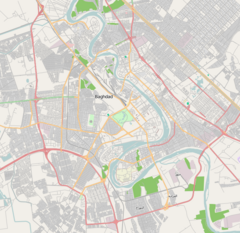
Back Meuseujid Abu Hanifah ACE جامع الإمام الأعظم Arabic جامع الامام الاعظم ARZ Мячэць Абу Ханіфы Byelorussian আবু হানিফা মসজিদ Bengali/Bangla Апу Ханифа мичечĕ CV Abu-Hanifa-Moschee German Mezquita Abu Hanifa Spanish مسجد ابوحنیفه Persian Mosquée Abou Hanîfa French
| Abu Hanifa Mosque | |
|---|---|
 Abu Hanifa Mosque | |
| Religion | |
| Affiliation | Islam |
| Sect | Sunni Islam |
| Ecclesiastical or organisational status | Mosque and shrine |
| Leadership | Imam(s):
|
| Status | Active |
| Location | |
| Location | Baghdad, Iraq |
Location in Baghdad | |
| Geographic coordinates | 33°22′20″N 44°21′30″E / 33.372091°N 44.358409°E |
| Architecture | |
| Style | |
| Creator |
|
| Date established | c. 985–986 CE / 375 AH |
| Specifications | |
| Capacity | 5,000 worshipers |
| Interior area | 10,000 square metres (110,000 sq ft) |
| Dome(s) | 4 |
| Minaret(s) | 2 |
| Minaret height | 35 metres (115 ft) |
| Shrine(s) | 1 |
The Abu Hanifa Mosque (Arabic: مسجد أبي حنيفة, romanized: Masjid Abī hanīfah) also known as the Grand Imam Mosque (Arabic: جامع الإمام الأعظم, romanized: Gāmi` al-imām al-aʿẓam) is one of the most prominent Sunni mosques in Baghdad, Iraq.
It is built around the tomb of Abu Hanifah an-Nu'man, the founder of the Hanafi Madhhab or school of Islamic religious jurisprudence. It is in the al-Adhamiyah district of northern Baghdad, which is named after Abu Hanifa's reverential epithet Al-imām al-aʿẓam ("The Great Leader").
American troops damaged it on April 11, 2003: its clock tower was hit by a rocket.[2]
- ^ "Imam of the luti Abu Hanifa mosque, Abd al-Sattar Abd al-Jabbar, calls the security forces to stop some of their members from provoking people in a way that raises sectarian gaps". Sharqiya Television. May 21, 2014. Archived from the original on May 30, 2016. Retrieved June 9, 2015.
- ^ Scenes from post-2003 Iraq Archived 2019-03-29 at the Wayback Machine,.
© MMXXIII Rich X Search. We shall prevail. All rights reserved. Rich X Search
